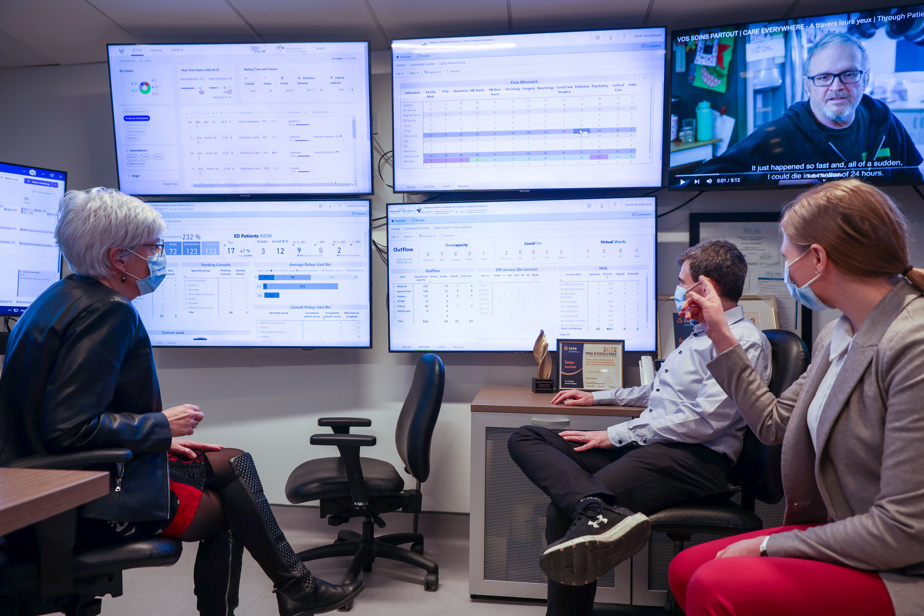At a time when the big shift towards home care is long overdue in Quebec, the Jewish General Hospital of Montreal is working hard. Patients are now followed for a variety of medical conditions, directly in the comfort of their homes.
After successfully escaping it since the start of the pandemic, Ted Samuels contracted COVID-19 at the end of January. The Montrealer was admitted to the Jewish General Hospital a few days after his condition began to deteriorate. “Unlike a lot of people, I was fine in the hospital. I had a private room, and the treatments were great,” he recalls.
After two weeks of hospitalization, the medical team offered to continue his follow-up at home. “I had a small fear that I might take less good care of myself than the nurses were taking care of me,” he confides, in an interview with The Press.
A total of four nurses and three doctors monitored his condition remotely. Different sensors worn on the skin allowed health professionals to monitor heart rate, pressure, saturation and temperature in real time.
They called me twice a day. It was a bit like being in the hospital, but at home.
Ted Samuels
A program created in a few hours
The virtual unit at the Jewish General Hospital celebrated its first anniversary in January. “In January 2022, we had a meeting on a Friday afternoon at 2 p.m. The CEO said, ‘I want a home hospital on Monday morning,'” recalls virtual care medical director Dr.r Lawrence Rudsky.
“We mobilized about fifty people during the weekend across all professions. It was really impressive, ”adds Joanne Côté, director of the direction of quality, transformation, evaluation, valuation and ethics (DQTEVE) and virtual care.

PHOTO ROBERT SKINNER, LA PRESSE ARCHIVES
The Jewish General Hospital of Montreal
For the first three months, the service was reserved for patients with COVID-19. In the past year, the team has taken the experiment further with patients suffering from heart failure, lung disease and pneumonia, among others.
So far, 198 patients have been hospitalized at home for an average of seven days. More than 70 others, requiring lighter medical follow-up, participated in the home recovery program.
Select patients carefully
To be monitored at home, the patient must be stable and ideally have the help of a caregiver at home. “There is a nurse who assesses the patient and makes sure he has a good profile for the program. Then the patient has the choice of staying in the hospital or going home,” says Co-Administrative Director of Virtual Care and Deputy Director of DQTEVE Erin Cook.
Once or twice a day, a multidisciplinary team of doctors and nurses contacts the patient by videoconference. The hospital provides the patient with an electronic tablet and technological support.
An application even allows nurses to start the virtual meeting on behalf of the patient. “The patient really just needs to turn on the surface. So it works even for people who are less comfortable with technology,” says the coordinator of the DQTEVE Transformation component, Kimberly Gartshore.
On the second floor of the hospital, data on the condition of patients monitored at home is displayed in real time on screens. This command center allows healthcare professionals to act as soon as non-standard indicators are detected.
Grow the program
So far, 93% of patients have said they are satisfied with their home care experience, says Ms.me Cook.
Just before Christmas, we had a 97-year-old patient who was followed at home and who died a few weeks later. The family thanked us because that man got to have one last birthday party at his house before he died.
Kimberly Gartshore, coordinator of the Transformation component of the DQTEVE
In the coming months, the hospital wants to “continue to grow and develop” its home care program. “One thing that prevents us from developing further is that 56% of our patients do not come from our territory. So we cannot admit them to the program, because we have to ensure home care for these people, ”notes however Ms.me Cook.
Eventually, if other health facilities join the program, the number of patients followed could be greatly increased, argues Ms.me Cook. “There is definitely an interest on the part of the Ministry [de la Santé] to further develop this program in other institutions across the province, she says. So we are very happy. »
